Canadian Aquaculture R&D Review 2009
Table of Contents
Introduction
Integrated aquaculture systems to be tested on commercial scale at BC site
Is it possible to rear commercial quantities of several marketable seafoods on fish waste and sunshine within a full-scale finfish net pen operation? If the “devil is in the details”, work now underway in BC is answering some of the crucial questions around commercial scale development of Integrated Multi-Trophic Aquaculture (IMTA) systems, or what team leader Dr. Steve Cross of Kyuquot SEAFoods Ltd. calls Sustainable Ecological Aquaculture (SEA).
Over the past two years a study funded by DFO‘s Aquaculture Collaborative Research and Development Program (ACRDP) has been investigating the feasibility of a full-scale sablefish/ sea cucumber/ sea urchin/ shellfish/ kelp operation, with a focus on three seminal questions:
- Can sea cucumbers effectively use the settled waste below net pens, via an infrastructure that is functionally independent from the finfish operation?
- Can modifications be made to steel cages to accommodate more range of depth for shellfish than is possible with traditional wooden rafts?
- Can kelp seed be set throughout the year to ensure consistent, adequate interception of dissolved nutrients and continuous, commercially viable production?
Answers from these lines of investigation, according to Cross, will determine critical details of the system’s design and operation, and allow SEA systems to be more adaptable.
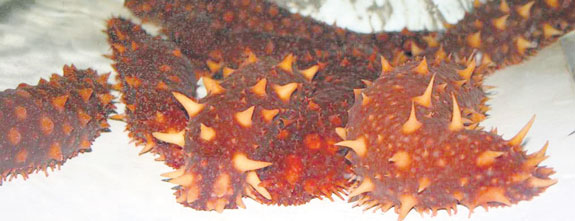
With a grant from DFO-ACRDP, and co-funding from Kyuquot Seafoods Ltd. of Courtney, BC, Dr. Steve Cross, and Drs. Chris Pearce and Lucy Hannah of DFO are concluding preliminary studies on sea cucumbers. They have engineered and built a prototype movable tramway system to service shellfish lines suspended within fish cage superstructures, and designed and tested submergible culture trays that can be positioned beneath net pens, and operated without interfering with the pens.
According to Cross, preliminary results strongly indicate that sea cucumbers will utilize waste deposits below fish pens as a food source, and do not appear to accumulate heavy metals or other trace contaminants. Sea cage modifications developed during the study will facilitate simultaneous culture of more than one type of shellfish (e.g., mussels near the surface, scallops at depths up to 15 m.). Timing of kelp seedling development can be controlled to allow year-round seeding and harvest.
A site in Kyuquot Sound, on the West Coast of Vancouver Island, will be the proving ground for both equipment and grow-out protocols based in part on the results of this work, and will act as an ongoing test site for future research and development. It is the first multi-trophic SEA site to be approved in BC. Other IMTA sites exist in New Brunswick on the East Coast.
Duration: Apr ’07 – Jun ‘09
Funded by: DFO-ACRDP. Co-funded by: Kyuquot SEAFoods Ltd.
Project team: Steven Cross (Kyuquot SEAFoods Ltd. and U Vic), Chris Pearce (DFO), Lucy Hannah (U Vic), Nathan Blasco (U Vic).
For more information contact: Steve Cross ( sfcross@office.geog.uvic.ca).
IMTA project investigates adding polychaete worms as additional biofilter
The Canadian aquaculture industry is striving to become more sustainable and environmentally benign. The underlying principle behind the Integrated Multi-Trophic Aquaculture (IMTA) concept is one of re-cycling nutrients for more profitability and sustainability. In essence, the IMTA practice combines, in the right proportions, the cultivation of fed aquaculture species (e.g., finfish) with organic extractive aquaculture species (e.g., filter feeders, deposit feeders) and inorganic extractive aquaculture species (e.g., seaweed).
While recent research shows that mussels are effectively filtering the fine organic particulates coming from the salmon site, the majority of the organic loads settling to the bottom are too large for mussels to physically handle. Therefore, the waste energy coming from the salmon faeces needs to be recycled through detritivores or decomposers before it reaches the sea bottom; preferably one that also has a commercial value. One group of organisms that would fit the detritivore criteria for finfish aquaculture is the polychaetes.
This study evaluated the feasibility of using polychaete worms (Nereis virens) in an IMTA operation with salmon. Lab study showed that the worms could be grown successfully on a diet composed of salmon food/feces. However, field trials indicated that production was lower than expected. Prototype culture containers were developed during the project.
Duration: Jul ‘07 – Mar ‘09
Funded by: DFO-ACRDP. Co-funded by: Cooke Aquaculture Inc.
Project team: Shawn Robinson (DFO), Rachel Shaw (DFO), Fernando Salazar (DFO), Craig Smith (DFO), Jim Martin (DFO), Terralynn Lander (DFO), Cooke Aquaculture Inc.
For information contact: Shawn Robinson ( Shawn.Robinson@dfo-mpo.gc.ca)
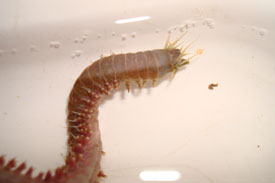
The sand worm, Nereis virens, in a white plastic dish in the lab. The species is being examined as one of potential organic biofilters from the detritivore trophic level.
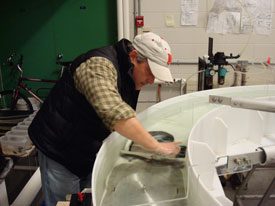
Particulate engineer, Darren Cleaves, working on some of the flow characteristics of organic particles in the lab and how they may be possibly captured by a cage for polychaete worms.
IMTA study finds salmon farm by-product particulates affect biophysical properties of mussel faeces
Mussels cultured under Integrated Multi-Trophic Aquaculture (IMTA) techniques are supplemented with pulses of salmon farm particulate nutrients. The effect of these particles on the biophysical properties of mussel biodeposits is unknown and is essential information for modelling nutrient dynamics of IMTA systems.
Researchers in this project are characterizing the effect of various diets (mix algal paste, diatoms paste,salmon feed ‘fines’ and salmon faeces) on the biophysical properties (faecal morphometrics, organic content and density) of mussel faeces produced.
All diets in the experiments were fed to three mussel size classes (small: 30 - 35 mm, medium: 50 – 55 mm, and large 70 – 75 mm). The team found that differences in faecal deposit characteristics are minimal within small mussel sizes, but become more significant as mussel lengths increase (50 mm to 75 mm). Absorption efficiencies of mix algal, diatom, salmon feed and salmon faces, were 87, 81, 90, and 86% (all significantly different, p < 0.05) respectively. Regardless of diet, small mussels produced biodeposits that dispersed over larger areas than those produced by larger mussels as a function of sinking velocity: small 0.18 cm sec-1, medium 0.29 cm sec-1 and large 0.54 cm sec-1 (sinking velocity of 50 % of particles).
Duration: Oct ‘07 – Feb ‘09
Funded by: ACOA-AIF. Co-funded by: DFO
Project team: Matthew Liutkus (DFO), Shawn Robinson (DFO), Bruce MacDonald (DFO), Gregor Reid (DFO), Cooke Aquaculture Inc.
For information contact: Matthew Liutkus ( Mathew.Liutkus@dfo-mpo.gc.ca)
Study to shed light on effects of organic enrichment by salmon in IMTA systems
The flow of nutrients from salmon farms and their effects on the growth and reproductive physiology of species within the localized farm ecosystem is not clearly understood. This project aims to better understand these pathways and effects within Integrated Multi-Trophic Aquaculture (IMTA) farms in Southeast New Brunswick.
Mytilus edulis, Strongylocentrotus droebachiensis and Caprella mutica - representing filter feeding molluscs, scavenging echinoderms and opportunistic crustaceans, respectively - have been selected to investigate the contributions to the pathways of effects.
The assimilation of salmon farm waste by these species is being investigated over a one year period using stable isotope and fatty acid tracers. The effect of this diet on growth and reproduction is then measured by calculating differences in growth and reproductive output of animals held within and outside of the nutrient plume of three salmon farms.
These species, representing different functional groups and trophic levels within the organic extractive niche of the IMTA farm, provide insight into the effects of organic enrichment on secondary production and trophic energy transfer efficiencies. Such research is essential for calculating the nutrient recovery potential of IMTA candidate species. Ultimately this research improves our understanding of energy flow and effects within IMTA sites and coastal ecosystems.
Duration: May ‘07 – May ’10
Funded by: ACOA-AIF
Project team: Jason Mullen (DFO), Shawn Robinson (DFO), Bruce MacDonald (DFO), Gregor Reid (DFO), Cooke Aquaculture Inc.
For information contact: Jason Mullen ( Jason.Mullen@dfo-mpo.gc.ca)
Researchers incorporate sea urchins into IMTA system
Integrated Multi-Trophic Aquaculture (IMTA) is proving to be successful in the Bay of Fundy with salmon, mussels, and kelp as the initial bio-extractive components. Currently, several detritivores species are being considered for incorporation into the IMTA system in order to further improve the level of nutrient recycling in an open marine environment for finfish aquaculture.
The green sea urchin appears to be a promising candidate because of its relatively high economic value and ability to ingest larger organic particles descending from finfish cages. They are often found around salmon aquaculture sites.
This project is evaluating the potential relative growth performance of sea urchins from aquaculture sites compared to nearby reference areas. A relationship between the test diameter and the length of the rotules found in Aristotle’s lantern, the chewing organ of the sea urchin, has been observed.
Using the growth rings found in the rotules, researchers are comparing animals from different sites to evaluate the hypothesis that sea urchins around the aquaculture sites experience higher growth rates than conspecifics in nearby natural areas. This project is part of a larger initiative looking at the degree to which aquaculture sites impact the relative growth rates of organisms away from the site.
Duration: Dec ‘08 – Mar ’09
Funded by: DFO
Project team: Shawn Robinson (DFO), Andrew Cooper (DFO), Janelle Arsenault (DFO), Carissa Graydon (DFO), Jacquelyn Ferris (DFO), Jim Martin (DFO), Terralynn Lander(DFO), Craig Smith (DFO)
For information contact: Shawn Robinson ( Shawn.Robinson@dfo-mpo.gc.ca)
IMTA group examines recycling of aquaculture nets for the collection of mussel seed
In order to successfully implement mussels as a full commercial crop in the Integrated Multi-Trophic Aquaculture (IMTA) system, a consistent collection source for juveniles (‘spat’ or ‘seed’) must be identified. Researchers have been examining the potential for reusing old salmon nets previously treated with cuprous oxide for mussel spat collection in the Bay of Fundy.
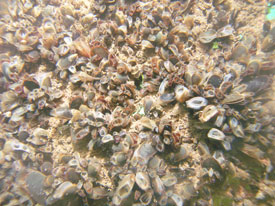
Juvenile mussels that have settled on used salmon nets that will be shortly harvested and re-deployed in socks hung on IMTA mussel rafts (Photo by S. Robinson)
The settlement density and shell length of blue mussels was measured on newly treated (NT), previously treated (PT) and untreated (UT) collector panels, made from commercial salmon nets, to assess how mussel spat collection efficiency was affected by commercial cuprous oxide treatment.
Significant differences were found between treatments for mean spat density (MSD) after a 5 months. Reduced settlement on NT and PT panels was attributed to the inhibitory effects of cuprous oxide on mussel settlement. Although PT panels collected fewer spat than UT panels, the numbers were still adequate for commercial spat collection. Mean shell length (MSL) was not significantly different between treatments.
Based on these results, the research team believes there is potential for recycling used salmon nets for mussel collection as PT panels continued to collect large numbers of mussel spat while inhibiting unwanted foulers with lingering anti-foulant properties.
Duration: Jun ‘07 – Dec ’07
Funded by: DFO
Project Team: Shawn Robinson (DFO), Rachel Shaw (DFO), Terralynn Lander (DFO), Jim Martin (DFO), Cooke Aquaculture Inc.
For information contact: Shawn Robinson ( Shawn.Robinson@dfo-mpo.gc.ca)
Newfoundland project investigates mussels to mitigate some impacts of cod aquaculture
Newfoundland researchers are investigating the feasibility of culturing mussels, Mytilus edulis, as a component in a cod Integrated Multi-Trophic Aquaculture (IMTA) system. They are evaluating the effluent leaving an onshore Atlantic cod aquaculture site as a food source for mussels.
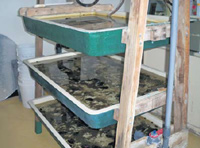
Experimental exposure trials at Memorial University (Ocean Sciences Centre) (Photo: A. Both)
Experiments are being undertaken to measure changes in the biochemical composition of mussels fed effluent in comparison with starved mussels and mussels fed algae over a ten week period. The growth of mussels fed cod effluent is also being measured over a six month period and compared to that of starved mussels and algae fed mussels. Some smaller experiments on individuals will be undertaken to determine the ability and extent to which M. edulis can filter cod effluent out of surrounding waters.
Some preliminary analyses are revealing that the bulk of the effluent leaving cod tanks (96%) is of a size larger then 500 µm which is too large for mussels to ingest, with a small portion (1.8%) being smaller then 70 µm and of a size suitable for mussel ingestion. Preliminary settlement rate experiments are showing that although the smaller particles comprise a small portion of the effluent they are the particles with the greatest capacity to spread over large areas.
Duration: Feb ‘08 – Feb ’10
Funded by: NSERC. Co-funded by: DFO
Project team: Chris Parrish (MUN), Adrianus Both (MUN), Randy Penney (DFO), Ray Thompson (MUN)
For information contact: Chris Parrish ( cparrish@mun.ca)
Research suggests new benefit of IMTA in pathogen depletion by mussels
One of the methods currently being considered in the evolution of aquaculture in Canada is a practice known as Integrated Multi-Trophic Aquaculture (IMTA). When different organisms are combined, either intentionally or unintentionally, the possibility exists for biological interactions to occur.
In commercial aquaculture situations, negative interactions could be expressed in the form of disease transfer or parasites and this has been the concern of several countries in adoption of IMTA principles.
However, studies are beginning to emerge that suggest mussels may have the ability to destroy the ISA virus. IMTA researchers are determining the ability of mussels to affect the occurrence and titre levels of various fish pathogens in their environment.
The results from this experiment suggest that mussels are effective at depleting the ISAV and the IPNV viral types. However, they are not as effective on Nodavirus suggesting different mechanisms are involved.
Mussels do not seem to deplete BKD or furunculosis bacteria in the water column in the same fashion as viruses. Although there are trace amounts of bacteria remaining, it is not clear whether these are able to be released back into the environment. More work is going to be done on these mechanisms.
Duration: Aug ‘07 – Mar ‘08
Funded by: DFO-ACRDP. Co-funded by: Cooke Aquaculture Inc., RPC
Project team: Shawn Robinson(DFO), Rachael Ritchie (RPC), Ben Forward (RPC), Brian Glebe (DFO), Terralynn Lander (DFO), Wilfred Young-Lai (DFO)
For information contact: Shawn Robinson ( Shawn.Robinson@dfo-mpo.gc.ca)
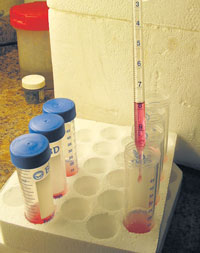
Titers of virus to be placed in the experimental tanks with mussels to determine the ability of the shellfish to remove virus from the water column
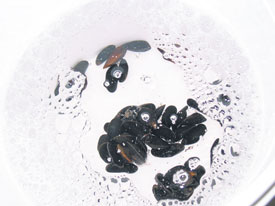
Mussels in white plastic bucket with viral titer added in the quarantine facility at the St. Andrews Biological Station
- Date modified: